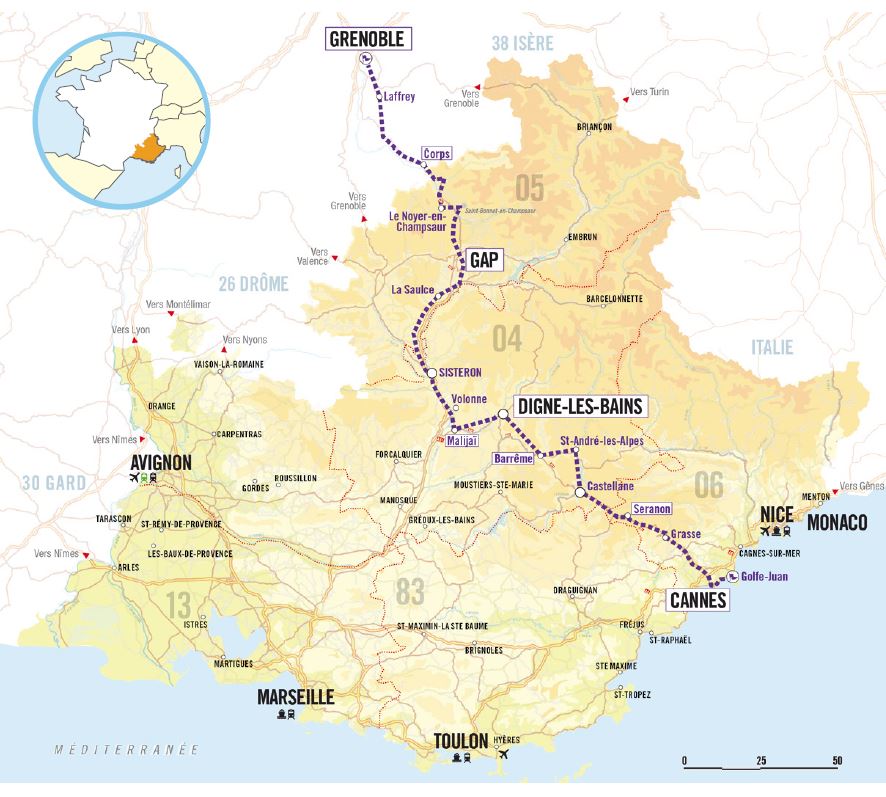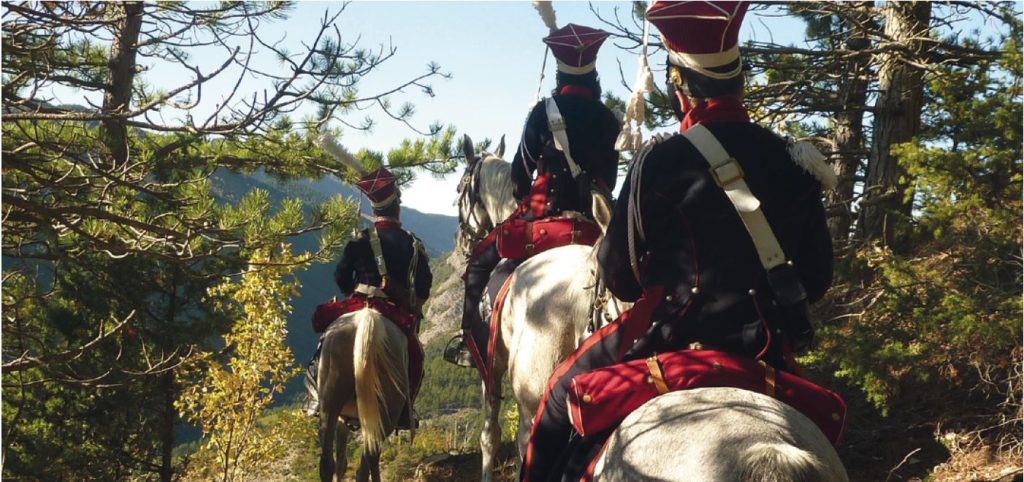Nearly 200 years after his death, the figure of Napoleon continues to fascinate all over the world! His military genius is undisputed and many of his strategies are still studied by military academies and enthusiasts around the world.
Glory is fleeting, but obscurity is forever.
Napolean I

According to a study conducted by the CRT PIDF, 74% of foreign visitors questioned consider Napoleon I to be the most important person in French history. The visitors best informed on this historic figure are from Russia, Germany and the Netherlands, while those from China and the UK show the most interest in this period in history.
In the Provence-Alpes-Côte d’Azur Region and the Isère département, many Remembrance Sites remain along the famous route the deposed Emperor followed to reach Paris and start his second reign: the “Hundred Days.”
The main sites of interest can be explored by bicycle, car, horseback, in the air or simply on foot; made accessible by a number of tourist routes created by the local tourism trade. The Bicentenary will also be celebrated with a number of historical re-enactments from 28 February to 8 March 2015, with many other events scheduled for the summer.
HISTORICAL BACKGROUND
Napoleon, sensing that France was still profoundly favourable to him and swayed by the situation prevailing in the country and threats weighing on his life, decided to return to French soil in 1815 and reclaim his throne. France was split in two by King Louis XVIII’s Charter of 1814 and, especially, governmental measures: facing the Royalists, on one side, the great majority of the French people were indebted to the Revolution, which had given rise to Napoleon. The Emperor’s return from the Isle of Elba interrupted the fierce struggle tearing France apart. Two proclamations circulated in France. They called for an uprising against the Bourbon rulers. The “Flight of the Eagle” ended in Paris after 20 days without a single gunshot having been fired. Landing on 1 March 1815 in Golfe-Juan with over a thousand men, Napoleon went on to Grenoble along the Route of the Alps to avoid Royalist populations in the Rhône Valley. Thus, he crossed Provence, where the people remained indifferent, or rather unresponsive, until Sisteron, although the first demonstrations in his favour were observed after he left Saint-Vallier. As he crossed the Dauphiné, he was greeted with enthusiasm until Laffrey. There, the troops sent by King Louis XVIII were waiting to arrest him. The soldiers, hearing the Emperor’s first words, rallied to his cause and preceded him in his triumphal march to Paris. On entering Grenoble, on 7 March, in his own words, the adventurer was once again a Prince. As he continued on to Paris, he was joined by many nostalgic soldiers and mustering growing support from the people. He was returned to power on 20 March and held it for a “Hundred days” until 22 June 1815. Defeated at Waterloo and forsaken by the Chamber, he was forced to abdicate once again on 22 June 1815 in favour of his son, and was sent into exile on Saint Helena, where he died on 5 May 1821. Created, in 1930, Route Napoléon retraces this historic saga.

THE FIRST TOURIST ROUTE
The first Tourist Route dedicated to this historical event “Route Napoléon” was created in France in 1932. Despite the passing of two centuries the “Flight of the Eagle,” the landing of the Imperial troops in Golfe-Juan, the perilous crossing of the Alps, the meeting at
Laffrey, the entry into Grenoble, still continues to fascinate people today.
The traces left by Napoleon’s passage kept up and embellished in the 19th century, inspired the emergence of a new series of Remembrance Sites in the Alps. The transport revolution begun in the latter half of the 19th century offered the villages concerned a chance to make this shared heritage a genuine economic asset: pilgrims were replaced by tourists. In light of this and the rise of tourism after World War I, Route Napoléon received official consecration in 1932.
The former RN (Route Nationale) 85, 314km long today, runs through exceptional landscapes from the sea to the mountains. It begins with a maritime section from Portoferraio (Isle of Elba) to Golfe-Juan, then continues on land from Golfe-Juan to Grenoble through two Regions, four départements and over 40 communes with an exceptional cultural and natural heritage. This journey is still considered to have been a feat, given the conditions in which Napoleon’s men followed the route, the difficult and even hazardous circumstances, burdened with heavy loads in harsh weather, moving at a strenuous pace. His soldiers were reputedly excellent hikers, which contributed to their many victories.
“Questioned by his Irish physician, Barry O’Meara, at Saint Helena, Napoleon confided that the happiest time of his life was ‘the march from Cannes to Paris,’ an unforgettable time when France was offered to him without a fight, as if under a spell…” (Source: Route Napoléon Insolite, by Jacques L’Azou).
This itinerary, followed by the Emperor and his loyal troops in their prodigious adventure, was named “Route Napoléon,” thereby leaving a mark on national tourism, since it was France’s very first Tourist Route, still very popular today with the public, whether or not they are fascinated by Napoleon.
ANERN is the national association of elected officials for Route Napoléon grouping 42 communes located along
the itinerary. In 2015, it printed a leaflet for the Bicentenary.
www.route-napoleon.com

STEP BY STEP
IN NAPOLEON’S FOOTSTEPS FROM GOLFE-JUAN TO GRENOBLE
- PORTOFERRAÏO
- VALLAURIS / GOLFE-JUAN / CANNES
- LE CANNET / MOUGINS / MOUANS-SARTOUX / GRASSE
- SAINT-VALLIER-DE-THIEY / ESCRAGNOLLES / SERANON
- CASTELLANE / SAINT-ANDRÉ-LES-ALPES / BARREME
- HAMEAU DE LA CLAPPE (CHAUDON–NORANTE) / DIGNE-LES-BAINS / MALIJAI
- VOLONNE / SISTERON
- CHATEAUVIEUX / LE POËT / UPAIX / VENTAVON / MONÊTIER-ALLEMONT
- LA SAULCE DES ALPES / TALLARD / GAP
- LE CHAMPSAUR / CORPS
- LA MURE D’ISERE / LAFFREY / VIZILLE / TAVERNOLLES / GRENOBLE
OTHER USEFUL LINKS

